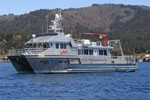AKA: none
Other ID: F-2-08-NC
Status: Completed
Organization(s): USGS, Pacific Coastal and Marine Science Center
Funding Program(s):
Principal Investigator(s): Guy Cochrane, Brian Edwards
Affiliate Investigator(s):
Information Specialist(s): Brian Edwards
Data Type(s): Imagery: Photo, Imagery: Video, Location-Elevation: Navigation
Scientific Purpose/Goals:
Vehicle(s):
Start Port/Location:
End Port/Location:
Start Date: 2008-08-31
End Date: 2008-09-08
Equipment Used: GPS, underwatervideo, underwatercamera
Information to be Derived:
Summary of Activity and Data Gathered:
Staff:
Affiliate Staff:
Notes: proposed early Sept. 7 days. Camera work with Hank Chezars camera sled; possibly sampling with grab sampler; possibly running minisparker.
Location:
Pt. Arena to Stinson Beach
| Boundaries | |||
|---|---|---|---|
| North: 38.92604 | South: 37.47892 | West: -123.76 | East: -122.47884 |
Platform(s):
 Fulmar |
Johnson, S.Y., Dartnell, P., Golden, N.E., Hartwell, S.R., Erdey, M.D., Greene, H.G., Cochrane, G.R., Kvitek, R.G., Manson, M.W., Endris, C.A., Dieter, B.E., Watt, J.T., Krigsman, L.M., Sliter, R.W., Lowe, E.N., and Chin, J.L., 2015, California State Waters Map SeriesâOffshore of Salt Point, California: In: Johnson, S.Y., and Cochran, S.A. (Eds.). U.S. Geological Survey Open-File Report 2015-1098.
FAN F208NC has data viewable in the CMGP Video and Photograph Portal. View the data in this application here. See the instructions for working with this application.
| Survey Equipment | Survey Info | Data Type(s) | Data Collected |
|---|---|---|---|
| GPS | --- | Navigation | Global positioning system (GPS) data f-2-08-nc.060 (Provisional best file) Best file with nav in ArcInfo E00 format |
| underwatervideo | --- | Video | Seafloor character--Offshore of Bolinas, California (This raster-format seafloor-character map shows four substrate classes of Offshore of Bolinas, California. The substrate classes mapped in this area have been further divided into the following California Marine Life Protection Act depth zones and slope classes: Depth Zone 2 (intertidal to 30 m), Depth Zone 3 (30 to 100 m), Slope Class 1 (0 degrees - 5 degrees), and Slope Class 2 (5 degrees - 30 degrees). Depth Zone 1 (intertidal), Depth Zone 4 (100 to 200 m), Depth Zone 5 (greater than 200 m), and Slopes Classes 3-4 (greater than 30 degrees) are not present in the region covered by this block. The map is created using a supervised classification method described by Cochrane (2008).) F208NC_video_observations (This part of DS 781 presents video observations from cruise F208NC in northern California. The vector data file is included in ""f208nc_video_observations.zip,"" which is accessible from https://pubs.usgs.gov/ds/781/video_observations/data_catalog_video_observations.html. Between 2006 and 2007, the seafloor in central California was mapped by California State University, Monterey Bay, Seafloor Mapping Lab (CSUMB) and by the U.S. Geological Survey (USGS), using both multibeam echosounders and bathymetric sidescan sonar units. These mapping missions combined to collect bathymetry and acoustic-backscatter data from about the 10-m isobath to out beyond the 3-nautical-mile limit of California's State Waters. To validate the interpretations of sonar data in order to turn it into geologically and biologically useful information, the USGS ground-truth surveyed the data by towing camera sleds over specific locations throughout the region. During the 2008 ground-truth cruise, the camera sled housed two video cameras (one forward looking and the other vertical looking), a high-definition video camera, and an 8-megapixel digital still camera. The video was fed in real time to the research vessel, where USGS and NOAA scientists recorded both the geologic and biologic character of the seafloor into programmable keypads once every minute. In addition to recording the seafloor characteristics, a digital still photograph was captured once every 30 seconds. This ArcGIS shape file includes the position of the camera, the time each observation was started, and the visual observations of geologic and biologic habitat.) |
| underwatercamera | --- | Video Photo | Line101 Line113 Line114 Highlights Line112 Line100 Line115 Line102 Line105 Line107 Line108 Line109 Line110 Line103 Line104 Line106 Line111 |